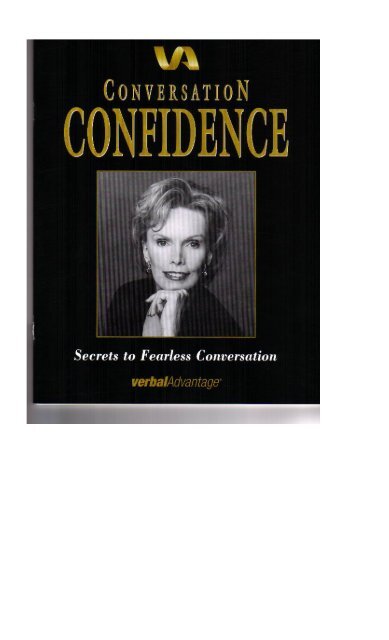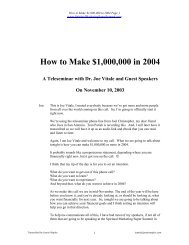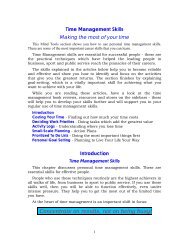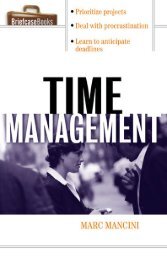Leil Lowndes - Conversation Confidence.pdf - Motivational Magic
Leil Lowndes - Conversation Confidence.pdf - Motivational Magic
Leil Lowndes - Conversation Confidence.pdf - Motivational Magic
Create successful ePaper yourself
Turn your PDF publications into a flip-book with our unique Google optimized e-Paper software.
CONVERSATION CONFIDENCE<br />
with <strong>Leil</strong> <strong>Lowndes</strong><br />
TAPE 1A: HOW TO MAKE AN UNFORGETTABLE FIRST IMPRESSION<br />
Introduces the series and gives you 2 techniques you can start using immediately to create a dynamic first impression in<br />
the first minute or less. The first is a nonverbal technique which makes you come across as a confident, friendly and<br />
outgoing person. The other is a verbal device which creates a feeling of instant rapport with your conversational partner.<br />
TAPE IB: HOW TO CAPTIVATE ANYONE, ANYTIME, ANYPLACE<br />
Presents three techniques you can use on new acquaintances and friends alike to dazzle them with your friendliness and<br />
sincerity. Includes an 8-point checklist to use while conversing with everybody to make them feel that they (and therefore<br />
you) are a very special person.<br />
TAPE 2A: THE SECRET OF SMALL TALK<br />
discover the secrets of making charismatic conversation with new acquaintances, and why the first words out of your<br />
mouth are crucial. Includes a 4-point Small Talk Checklist to make sure you are on target with your opening words. Then<br />
learn the Secret of Small Talk to keep all your small talk appropriate and engrossing.<br />
TAPE 2B: TRANSITION FROM SMALL TALK TO DEEPER TALK<br />
Here are 6 techniques to shift from small talk into communication which is more engrossing and profound. Includes a<br />
linguistic trick to revive a conversation that is petering out, and another to uncover your conversational partners' hot<br />
buttons. Then learn a dozen rapport establishing phrases, and discover 2 unique methods of making a new acquaintance<br />
subconsciously feel like you are an old friend.<br />
TAPE 3A: HOW TO SOUND LIKE AN INSIDER IN ANY CROW][)<br />
Arms you with two techniques to make stimulating conversation in any group of people no matter how little you have in<br />
common. The first gives you methods when you know in advance what type of people you'll be talking to. The other is for<br />
when you "go in cold" and need to talk intelligently with a diverse 'group of strangers.<br />
TAPE 3B: MEGA REWARDS FOR MEGALISTENING<br />
Introduces a unique approach to listening. Brings the difficult task of absorbing the speaker's messages to life and makes it<br />
fun. You'll learn to pick up every subtlety be listening like a translator listens, a dancer listens, a film maker listens, a<br />
psychiatrist listens, ...and finally like a lover listens. With the 4-Point Listening Checklist, you then uncover their hidden<br />
messages and learn to give responses aimed right at their heart.<br />
TAPE 4A: HOW TO WORK A PARTY LIKE A POLITICIAN WORKS A ROOM<br />
Gives you the 6 questions politicians and serious socializers ask themselves before going to a party. Learn how to meet<br />
the people you want, and then how to gracefully get into __ and out of __ conversations with them. Practice the technique<br />
to present yourself as a fascinating person when they ask you, "And what do you do?" Discover the one item you should<br />
wear to every party, and learn the best way to follow up on the important people you meet.<br />
TAPE 4B: LET YOUR BODY DO THE TALKING<br />
Studies say approximately 75% of communication comes through body language. So here's the complete course in getting<br />
yours shaped up to express confidence, composure and credibility. You'll also learn how to read the other person's body<br />
language to unearth their hidden messages or tell if they are lying. And master Eyeball Selling, a technique to convince<br />
your listener of your ideas by watching their movements. Finally, you'll learn how to tell if someone of the opposite sex<br />
finds you attractive.<br />
TAPE 5A: REACH OUT AND TOUCH EVERYBODY .. BY PHONE<br />
Become a master phone communicator through these 10 topnotch telephone techniques. Learn how to show more<br />
personality on the phone and make everyone you call feel special. You'll learn ways to keep people absorbed in your<br />
phone conversations, and how subtle changes in the words you use make a big difference. You'll also learn what kind of<br />
voice mail messages to leave to make people perceive you as more intelligent and call you back.<br />
TAPE 5B: PUT PIZAZZ IN YOUR CONVERSATION WITH PRO'S TECHNIQUES<br />
Discern how you sound to your listeners and how to regulate the speed and tone of your voice. Discover image<br />
consultants' techniques to put passion in your conversation, and professional speakers' techniques such as using dramatic<br />
silences, collecting rich phrases and humor to entertain your listeners... and much more. Finally, learn actors' techniques to<br />
be completely relaxed when giving presentations to groups of people.
TAPE 6A: THE POWER OF PRAISE _ THE FOLLY OF FLATTERY<br />
Elevate praise to an art form and win many friends. Master the Killer Compliment, the Little Strokes Compliment, the<br />
Implied Compliment, the Grapevine Compliment, the Carrier Pigeon Compliment, the Bulls Eye Compliment, the Knee<br />
Jerk Compliment, and the Racking Compliment. You'll also discover the Boomerang Technique to make other people want<br />
to compliment you!<br />
TAPE 6B: CHEWING UP TOUGH COOKIES<br />
Learn the predictable patterns of tough cookies' annoying behavior, and how to chew them up so they don't even feel<br />
bitten. Here are step-by-step methods for dealing with negativists, constant talkers, the super-agreeable people who<br />
always let you down, hostile aggressive bullies, and snipers. Finally learn the magic catchall sentence that turns the worst<br />
of them around.<br />
TAPE 7A: DIFFERENT STROKES FOR DIFFERENT FOLKS AND DIFF RENT GENDERS<br />
Throughout history, philosophers and psychiatrists have divided people into four basic personality types. In this tape you<br />
learn how to determine your basic personality type. (Are you a box, a circle, a triangle or a squiggle?) Then you learn how<br />
to relate to the other boxes, circles, triangles and squiggles of the world. To further clarify our complicated<br />
communications conundrum, you'll examine differences in talking to men and talking to women.<br />
TAPE 7B: HOW TO PLAY CONVERSATIONAL HARDBALL... AND WIN<br />
Master The Converter, a powerful 5-step tool to persuade, sell, negotiate... and to win! Learn a foolproof pattern to<br />
sequence your concepts so you get your important ideas across. then how to tailor your points depending on who you're<br />
talking to. Discover ways to make your message hit home with real stories from your own life.<br />
TAPE 8A: ADVANCED RAPPORT ESTABLISHING TECHNIQUES<br />
Explores 7 subliminal rapport-establishing techniques. Learn how to emulate and capitalize on your conversational<br />
partners' background and experiences, clone their perceptions, and then create analogies and similes from their world.<br />
This tape gives you an advanced telephone technique for both deep rapport and crystal clear comprehension. Finally, here<br />
is a method for winning your conversational partners' hearts by doing their thinking for them!<br />
TAPE 8B: HOW TO TALK WITH TIGERS AND NOT GET EATEN A_LIVE<br />
This tape takes conversation to its highest level. It gives you sophisticated communication techniques which can mean the<br />
difference between staying on _ or toppling off the top rung of the social or corporate ladder. You'll learn advanced<br />
concepts like providing a Safe Haven for high level contacts, and always Knowing the Score in any relationship.<br />
The course ends on a lighter note with The Ten Common Phrases you should never ever say in everyday conversation!
CONVERSATION CONFIDENCE WORKBOOK<br />
<strong>Leil</strong> <strong>Lowndes</strong><br />
TAPE 1A: HOW TO MAKE AN UNFORGETTABLE FIRST IMPRESSION<br />
Introduces the series and gives you 2 techniques to create a dynamic first impression in the first minute or less. The<br />
first is a non-verbal technique which makes you come across as a confident, friendly and outgoing person. The<br />
other is a verbal device which creates a feeling of instant rapport with your conversational partner.<br />
********************<br />
The Carnegie Institute of Technology study revealed that in all fields:<br />
__% of financial success in life is due to professional knowledge.<br />
__% of financial success in life is due to good communications skills.<br />
Rank, in order, (#1 through #6) the top skills employers most consider when hiring:<br />
__ Previous work experience<br />
__ Recommendations from previous employers<br />
__ Good communication skills<br />
__ Professional Training<br />
__ Number of years of schooling<br />
__ A good attitude<br />
The first impression you make on a new acquaintance<br />
20%<br />
What you say<br />
30%<br />
The sound of your voice<br />
50%<br />
Your body language, your expressions,<br />
and how you move<br />
NON_VERBAL TECHNIQUE: THE HELLO OLD FRIEND TECHNIQUE<br />
To make a dynamic impression, and transform your body into that of an open, warm and friendly person without even<br />
thinking about it, imagine your n<br />
a _ _ _ _ _ _ _ _ _ _ _ is an o _ _ f _ _ _ _ _.<br />
VERBAL TECHNIQUE: ECHOING<br />
To give your conversational partner the feeling that you like their "family,"<br />
use their arbitrary c _ _ _ _ _ of w _ _ _ _<br />
Page 1
TAPE 1B: HOW TO CAPTIVATE ANYONE, ANYTIME, ANYPLACE<br />
Presents 3 techniques you can use on new acquaintances and friends alike to dazzle them with your friendliness<br />
and sincerity. Includes an 8_point checklist to use while conversing with everybody to make them feel that they<br />
(and therefore you) are a very special person.<br />
Technique #1: YOUR PERSONALITY SOFTENER<br />
********************<br />
To seem captivated by your conversational partner, use this 8-point checklist which transforms your body into that of a<br />
warm and friendly person.<br />
S is for __________<br />
While you are looking at someone, keep your eyes on theirs with an occasional glance at their most attractive facial<br />
feature.<br />
O is for __________<br />
When you stand in this position at a party, people will instinctively gravitate toward you.<br />
F is for __________<br />
When you take this body position, you reassure your CP (<strong>Conversation</strong>al Partner) that you genuinely like them.<br />
T is for __________<br />
In a new relationship, women can use this technique more often than men. However as a relationship progresses, men<br />
should do it more!<br />
E is for __________<br />
If you don't practice this technique, it will give your CP the subliminal message that you are bored with them.<br />
N is for __________<br />
This does not necessarily mean "I agree with you." But it does mean, "I understand."<br />
E is for __________<br />
Without this attribute, people will be bored with you no matter what you're talking about.<br />
R is for __________<br />
You can give your CP the subliminal feeling that you are attracted to them by playing with this technique.<br />
NOTE: ALL of the above warm and friendly body language signals happen automatically when you use the Hello Old<br />
Friend technique.<br />
Page 2
Technique #2: THE FLOODING SMILE<br />
To make everyone feel your smile is genuine and especially for them, don't smile too q _ _ _ _ _ _ .Look at them for a few<br />
seconds. Drink them in through your eyes. And then let a s _ _ _, warm, smile of appreciation flood over your face. And<br />
remember, the sincere smile involves your whole face, even your e _ _ _.<br />
Technique #3: THE STICKY EYES TECHNIQUE<br />
The time difference between tearing our eyes away from someone we love and looking away from a bore is a f _ _ _ _ _ _<br />
_of a s _ _ _ _ _ but it signifies "rejection" or "acceptance." To give your CP the impression that you are captivated by<br />
what they are saying, let your eyes l _ _ _ _ a f _ _ _ _ _ _ _ of a<br />
s _ _ _ _ _ longer on them before looking away.<br />
Technique #4: THE VISUAL VOYAGE TECHNIQUE<br />
To give your CP the impression that you enjoy looking at them, take a visual voyage all over their<br />
f _ _ _ while they are talking, concentrating mostly on their e _ _ _. Often<br />
s _ _ _ _ _ _ makes us avoid looking directly at someone.<br />
Technique #5: THE SNORE TECHNIQUE<br />
To make even boring people feel you find them interesting, use this beastly little trick. Think, "W _ _ _ a<br />
s _ _ _ _ this person is!" And then check your body for the S, the N, the 0, the R and the E from the acronym above. And,<br />
believe it or not, even you will begin to enjoy the conversation!<br />
Name three people you will intend to use YOUR PERSONALITY SOFTENER on:<br />
Friend:<br />
Family member:<br />
Co-Worker:<br />
After you use this technique on them, record their reactions. Did you notice how their response to you was more friendly<br />
than usual?<br />
Now, try the SOFTENER technique on the next person you meet and record their reactions to you:
TAPE 2A: THE SECRET OF SMALL TALK<br />
Discover the secrets of making charismatic conversation with new acquaintances, and why the first words out of<br />
your mouth are crucial. Includes a 4_point Small Talk Checklist to make sure you are on target with your opening<br />
words. Then learn the Secret of Small Talk to keep all your small talk appropriate and engrossing.<br />
Some important points on small talk to remember<br />
The secret of small talk is: It should be________<br />
The most important factor to consider in making is small talk is the s _ _ _ _ _ _ of what you are saying.<br />
Like in music, in small talk, the r _ _ _ _ _ the m _ _ _ _ _and the f _ _ _ _ _ _ are more important than your words.<br />
Whenever first meeting someone, let your s _ _ _ _ and your b _ _ _<br />
L _ _ _ _ _ _ _ carry the day.<br />
Concerning your first words, have the courage of your own t _ _ _ _ _ _ _ _<br />
Technique #1: THE COMM_YOU_NICATION TECHNIQUE<br />
Try to start as many sentences as you can with the magic little three-letter word,<br />
Technique #2: THE RESIST THE "QUICK_ME_TOO" TECHNIQUE<br />
Whenever you hear that you have something in common with your conversational partner, the longer you wait to reveal it,<br />
the more i _ _ _ _ _ _ _ _ he or she will be.<br />
THE SMALL TALK CHECKLIST Your very first words should be...<br />
1) N _ _ _ _ _ _and not t _ _ _ _ _ _ _ _ _ _<br />
When talking with a stranger, make sure that your first words reveal everything you want from that person.<br />
2) R _ _ _ _ _ _ _ to s _ _ _ _ _ _ _ _<br />
Try to make your first words relate to what is going on at the moment.<br />
3) P _ _ _ _ _ _ _, C _ _ _ _ _ _ _ _ _ _ _ _, or E _ _ _ _ _ _ _ _.<br />
If you say anything unpleasant or disagree too early in your conversation with a new acquaintance, that is 100% of their<br />
impression of your total personality.<br />
4) E _ _ _ to a _ _ _ _ w _ _ _ _<br />
In your first conversation with a new acquaintance, agreement on small points often subliminally determines whether the<br />
conversation will continue or not<br />
There are two kinds of people in this life. Those who walk into a room and say<br />
"Well, _ _ _ _ _ __!” And those who walk in and say,<br />
"Ah, _ _ _ _ _ _ _ _ _ _ _!” You want to be one of the latter.
TAPE 2B: TRANSITION FROM SMALL TALK TO DEEPER TALK<br />
Here are 6 techniques to shift from small talk into communication which is more engrossing and profound.<br />
Includes a linguistic trick to revive a conversation that is petering out, and another to uncover your conversational<br />
partners' hot buttons. Then learn a dozen rapport establishing phrases, and discover 2 unique methods of making<br />
a new acquaintance subconsciously feel like you are an old friend.<br />
Technique #1: CHERRY PICKING<br />
To make the conversation more interesting for your conversational partner, and to slide out of small talk, adjust the cherry<br />
picker in your ear. Listen for any a _ _ _ _ _ _, any d _ _ _ _ _ _ _ _, any d _ _ _ _ _ _ _ _ _, or any mention of another p _<br />
_ _ _, t _ _ _ or p _ _ _ _ _<br />
Technique #2: EMPLOY EMPATHIZERS<br />
Make liberal use of simple, short, supportive statements like "I can understand how you felt about that." Or "You made a<br />
wise choice," or "I'm so happy for you." Write a few of your own empathizes here:<br />
Asking about someone's job:<br />
What is a good substitute phrase if you are hesitant to ask a new acquaintance, "What do you do?"<br />
Technique #3: THE MOOD MATCH<br />
Before jumping into deeper conversation make a mood match. Take “p _ _ _ _ _ _ p _ _ _ _ _ _ _ _ _” of the other person<br />
to determine if they're in the mood to talk more meaningfully.<br />
The sequence of going from small talk to deeper conversation.<br />
1) Make a _ _ _ _ _ _ _ _ _<br />
2) Use their _ _ _ _<br />
3) Ask them an _ _ _ _ _ _ _ _ opener.<br />
Make sure your opening questions have a subtext of a _ _ _ _ _ _ _
Technique #4: THE TREE TECHNIQUE<br />
When you get stuck for good conversation, use the tree technique. Ask about a person's<br />
r _ _ _ _, their t _ _ _ _, their b _ _ _ _ _ _ _, or their l _ _ _ _ _.<br />
The progression of appropriate conversation from its most shallow small talk to closer communication<br />
goes from:<br />
1) Between strangers: _ _ _ _ _ _ _<br />
2) Between acquaintances: _ _ _ _ _<br />
3) Between friends: discussion of _ _ _ _ _ _ _ _<br />
4) Between intimates: talk about _ _ _ and _ _.<br />
Technique #5: SIGNAL SCRAMBLING<br />
To make new acquaintances subliminally feel like your friend, cut quickly to number<br />
____ above and use the discussion mode of intimates.<br />
Technique #6: CAPTIONING<br />
To make a new acquaintance feel like an old friend, develop a private joke (or even a pet name.) Whenever your<br />
conversational partner is telling a story, remember some part of it that they are _ _ _ _ _ _ _ _, and then refer to<br />
it later.<br />
TAPE 3A: HOW TO SOUND LIKE AN INSIDER IN ANY CROWD<br />
Arms you with 2 techniques to make stimulating conversation in any group of people no matter how little<br />
you have in common. The first gives you methods when you know in advance what type of people you'll<br />
be talking to. The other is for when you "go in cold" and need to talk intelligently with a diverse group of<br />
strangers.<br />
Technique #1: CONVERSATION HOMEWORK<br />
When you know the interests of the people you will be talking to, ask a friend who<br />
shares that interest about the i _ _ _ _ _ _ i _ _ b _ _ _ _ _ _ _ and the<br />
i _ _ _ _ _ _ h _ _ b _ _ _ _ _ _.<br />
Whenever discussing someone else's interests, it's important to throw out a<br />
l _ _ _ _ _ b _ _ _ to show you are knowledgeable.
Technique #2: SCRAMBLE THERAPY<br />
A technique when you don't you know the interests of the people you will be talking to: Once every three weeks do<br />
something totally out of your pattern to pick up the right words and the right questions to make you conversant in that<br />
interest for the rest of your life.<br />
Scramble therapy not only involves doing lots of things just once. It also means: Occasionally reading a different n _ _ _ _<br />
_ _ _ _ or m _ _ _ _ _ _ _<br />
Turning to a different s _ _ _ _ _ _ of your local _ _ _ _ _ _ _ _<br />
Going to lots of l _ _ _ _ _ _ _.<br />
Ask your friends about any special insider's g _ _ _ _ _ _ _ in their interest.<br />
TAPE 3B: MEGA REWARDS FOR MEGA-LISTENING<br />
Introduces a unique approach to listening. Brings the difficult task of absorbing the speaker's messages to life and<br />
makes it fun. You'll learn to pick up every subtlety by listening like a translator listens, a dancer listens, a filmmaker<br />
listens, a psychiatrist listens, and finally like a lover listens. With the 4-Point Listening Checklist, you then uncover<br />
your conversational partner's hidden messages and learn to give responses aimed right at their heart.<br />
********************<br />
The human mind is capable of thinking _ to _ times faster than the ear can listen.<br />
The five filters that words go through from the time they leave the other person's mouth until they reach our<br />
brain:<br />
1) The _ _ _ Filter<br />
2) The _ _ _ _ _ _ _ _ _ Filter<br />
3) The _ _ _ _ _ _ _ Filter<br />
4) The _ _ _ _ _ _ _ Filter<br />
5) The _ _ _ Filter<br />
We only up hearing about ___ % of what someone says.
The six ways to listen:<br />
Listen like a translator: To make what your CP is clearer and more memorable, p _ _ _ _ _ _ _ _ _ what he or she is<br />
saying in your own mind.<br />
Listen like a dancer. To express total empathy with your CP, become a w _ _ _ _ b _ _ _ l _ _ _ _ _ _ _<br />
Listen like a film maker: Since we remember only 7% of what we hear, and 85% of what we see, turn what we hear into<br />
what we see by p _ _ _ _ _ _ _ _ it like two little TV sets in front of our eyes.<br />
Listen like a psychiatrist: Listen between the lines and ask yourself, how does my CP _ _ _ _ about what he or she is<br />
saying.<br />
Listen like a lover: Realize that often the point of having a conversation is simply<br />
To _ _ _ _ _ _ _ _ _ _ _ _ _ _ _ _ _<br />
The four-point listening checklist.<br />
While listening, ask yourself the WHEW questions.<br />
W ___________________?<br />
H ___________________?<br />
E ___________________?<br />
W ___________________?
TAPE 4A: HOW TO WORK A PARTY LIKE A POLITICIAN WORKS A ROOM<br />
Gives you the 6 questions politicians and serious socializers ask themselves before going to a party. Learn how to<br />
meet the people you want, and then how to gracefully get into - and out of - conversations with them. Discover a<br />
technique to present yourself as a fascinating person when they ask you, "And what do you do?" Discover the one<br />
item you should wear to every party, and learn the best way to follow up on the important people you meet.<br />
THE SIX-POINT PARTY CHECKLIST<br />
Before going to a party, ask yourself the following questions:<br />
W _ _ is going to be there?<br />
W _ _ _ should I arrive?<br />
W _ _ is the party being given?<br />
W _ _ _ _ is the collective mind of the people at the party?<br />
W _ _ _ should I take to this particular party?<br />
H _ _ am I going to follow up on the people I've met at the party?<br />
Why is it a mistake to head right for the refreshment table?<br />
Why is it a mistake to talk mostly with your friends at a party?<br />
What is the simplest thing that both men and women are afraid to do in public if they don't know each other… but is the<br />
most effective way to meet people?
Technique #1: THE WHATZAT TECHNIQUE<br />
Search the _ _ _ _ _ _ _ _ of any attractive stranger you want to talk to and find something you can compliment and or ask<br />
about. Also, whenever you go to a party, wear an unusual piece of j _ _ _ _ _ _ or c _ _ _ _ _ _ _that anyone who finds<br />
you "the attractive stranger" can comment on.<br />
Technique #2: THE WHOZAT TECHNIQUE<br />
When you spot someone you would like to meet, ask the party giver for<br />
_____________________. If they are too busy, ask for a sentence or two<br />
________________________ so you have an opening approach.<br />
Technique #3: THE "LET'S MINGLE" TECHNIQUE<br />
When you'd like to move on and talk to someone else, what should you say to your conversational partner?<br />
Technique #4: THE "LATEST NEWS" TECHNIQUE<br />
What's the last thing you should do before leaving for a party?<br />
Technique #5: THE NUTSHELL RESUME<br />
Whatever your job, have something to say about your own work.<br />
Technique #6: THE INTRODUCTORY BAIT<br />
When introducing people to each other at a party, give their names and<br />
______________________________________________________<br />
Never say, "I'm terrible with names. What is yours again?" Instead say:<br />
Technique #7: THE PERSONALIZED POSTCARD<br />
Get a personalized post cards with _________________________________________printed on it.<br />
To follow up on an interesting contact at the party, send the card and refer to<br />
________________________________________ to personalize it.
TAPE 4B: LET YOUR BODY DO THE TALKING<br />
Studies say approximately 75% of communication comes through body language. So here's the complete course in<br />
getting your's shaped up to express confidence, composure and credibility. You'll also learn how to read the other<br />
person's body language to unearth their hidden messages or tell if they are lying. And master Eyeball Selling, a<br />
technique to convince your listener of your ideas by watching their movements. Finally, you'll learn how to tell if<br />
someone of the opposite sex finds you attractive.<br />
********************<br />
The study of body language is a science called “_ _ _ _ _ _ _ _.<br />
How can you tell if someone is lying by watching their body language?<br />
You can determine if someone is happy with what they are seeing or hearing, by watching the s _ _ _ or their p _ _ _ _ _.<br />
How can you tell a sincere smile from a false one?<br />
If you are having a disagreement with a good friend or someone you love, say what you must, but let body position m _ _<br />
_ _ _ his or hers to show solidarity.<br />
How can you tell who is the boss or "ranking individual" in any group?<br />
EYEBALL SELLING<br />
You can plan your sales pitch for your product, service or just your ideas by watching your listener's body positions. What<br />
should you do if you observe the following?<br />
1) Study their head position. Is their head turned away?<br />
2) Look at their body position. Is it turning away?<br />
3) Does their facial expression change? Become lively?<br />
4) Does your listener reach for an object?<br />
5) Are they pointing their fingers?<br />
6) Study their hands. Are their palms up?<br />
7) Is their head is nodding up and down?<br />
How to know if someone of the opposite sex finds you attractive:<br />
According to a scientific study, only 1 man in __ knew if a new female acquaintance was interested in him.<br />
Gentlemen, if you look at a woman you don't know and she looks away, it indicates she is interested if she looks up again<br />
at you within __ seconds.<br />
Determine the inches between your noses when you are chatting. If she lets you get within __ inches, she likes you.
TAPE 5A: REACH OUT AND TOUCH EVERYBODY … BY PHONE<br />
Become a master phone communicator through these 10 top-notch telephone techniques. Learn how to show more<br />
personality on the phone and make everyone you call feel special. You'll learn ways to keep people absorbed in<br />
your phone conversations, and how subtle changes in the words you use make a big difference. You'll also learn<br />
what kind of voice mail messages to leave to make people perceive you as more intelligent and call you back.<br />
About __ % of your energy level is lost over the phone.<br />
Technique #1: VERBAL SMILES'N NODS<br />
To replace the body language part of you communication, on the phone use verbal equivalents. What is your verbal<br />
equivalent of:<br />
A smile? ___________________________________________________________________<br />
A nod? _____________________________________________________________________<br />
An expression of surprise? ______________________________________________________<br />
A questioning look? ___________________________________________________________<br />
An admiring look? ____________________________________________________________<br />
Technique #2: THE "OH WOW, IT'S YOU!" TECHNIQUE<br />
Better than smiling before you answer the phone, exaggerate the warmth of your hello _ _ _ _ _ you find out who it is.<br />
Technique #3: NAME DROPPING TECHNIQUE (THEIR'S)<br />
To further personalize your phone communication, make even more liberal use of their _ _ _ _ on the phone than you<br />
would in person.<br />
Technique #4: THE CONSTANTLY CHANGING VOICE MAIL MESSAGE<br />
Studies have shown that people are perceived as more i _ _ _ _ _ _ _ _ _ _ and more on top of their<br />
b _ _ _ _ _ _ _ if they leave a voice mail message that they change every day or even every few hours.<br />
What's wrong with this voice mail message that says, "I'm either away from my desk or on the other phone right now?"<br />
Your voice mail message is like a verbal a _ _ _ _ _ _ _ for your business.<br />
Technique #5: THE CLIFF HANGER MESSAGE<br />
Whenever you leave a voice mail message for someone, try to leave a cliff hanger message so it gives them<br />
_________________________
Technique #6: WHAT COLOR IS YOUR TIME?<br />
Whenever you call anyone, always ask, "Is this a g _ _ _ t _ _ _ to talk?"<br />
Technique #7: LISTEN FOR BACKGROUND NOISES<br />
When you're listening to someone on the phone and you hear another line ringing or a dog or baby, ask if they:<br />
Technique #8: SALUTE THE SPOUSE<br />
Always a _ _ _ _ _ _ _ _ the person who answers the phone before asking for your party.<br />
Technique #9: THE PROP CHECK<br />
Get all your telephone m _ _ _ _ _ _ _ _ in order before answering the phone.<br />
Technique #10: THE MAKE BELIEVE HOLD BUTTON<br />
At home, don't let a family member s _ _ _ _ for you to come to the phone.<br />
Fill in the following acronym for sensitive hold button operation. When you must put them on hold, tell your caller:<br />
W _________________________________________________________<br />
H __________________________________________________________<br />
A __________________________________________________________<br />
T __________________________________________________________<br />
Never say just "thank you" at the end of a conversation. Always say:
TAPE 5B: PUT PIZAZZ IN YOUR CONVERSATION WITH PRO'S TECHNIQUES<br />
Discern how you sound to your listeners and how to regulate the speed and tone of your voice. Discover image<br />
consultants' techniques to put passion in your conversation, and professional speakers' techniques such as using<br />
dramatic silences, collecting rich phrases and humor to entertain your listeners... and much more. Finally, learn<br />
actors' techniques to be completely relaxed when giving presentations to groups of people.<br />
Record one of your phone conversations and listen to it afterward. Now, pretend you are a radio drama producer. What<br />
role would you cast your voice in?<br />
Count the number of words you speak per minute.<br />
Technique #1: TRANSFERENCE<br />
Think of something you really enjoy talking about (baseball? country music? tennis? ballet? your children? your<br />
computer?)<br />
Now, with that in mind, use the transference Technique described in the tape.<br />
Technique #2: THE TRUMPET BLARE PAUSE TECHNIQUE<br />
What should you do to make sure someone listens to your next words?<br />
Technique #3: YOUR PERSONAL THESAURUS<br />
Write a common adjective you use very often here. ________________________<br />
Now look it up in a thesaurus or book of synonyms. Read some of the synonyms and choose three or four that you feel<br />
comfortable with.<br />
___________________<br />
___________________<br />
___________________<br />
___________________<br />
Now practice working those words into your everyday conversations.<br />
When choosing phrases, choose the ones that have the most v _ _ _ _ _ impact.<br />
Make liberal use of q _ _ _ _ _ _ _ _ _, h _ _ _ _ and s _ _ _ _ _ _ _ _ _ to make your points.<br />
When you are presenting your important ideas, this body position is the most effective:<br />
What should you do with your hands?<br />
Technique #4: FONDLE THE ROOM TECHNIQUE<br />
In order to appear completely confident when you speak to a group, try to t _ _ _ _ the space you'll be talking in. If you<br />
can't do that, l _ _ _ carefully at it. And if you don't even have the opportunity to do that, be sure to v _ _ _ _ _ _ _ _ it.<br />
What is the worst time of the day to make a presentation?<br />
What is the worst day to make a presentation?<br />
The second worst?<br />
The best 2 days to make a presentation:<br />
When you must persuade, convince, cajole or otherwise bring someone around to your way of thinking, dress like them,<br />
but<br />
TAPE 6A: THE POWER OF PRAISE - THE FOLLY OF FLATTERY<br />
Elevate praise to an art form and win many friends. Master the Killer Compliment, the Little Strokes compliment,<br />
the Implied Compliment, the Grapevine Compliment, the Carrier Pigeon Compliment, the Bulls Eye Compliment, the<br />
Knee Jerk Compliment, and the Tracking compliment. You'll also discover the Boomerang Technique to make other<br />
people want to compliment you!<br />
Technique #1: THE KILLER COMPLIMENT<br />
Write the name of someone in your life who you would like to establish a deeper relationship with: (a boss? a loved one?<br />
a friend?)<br />
Now think of something very special about them, something you really like about them that you would not ordinarily tell<br />
them.
Now, at the next appropriate moment, give them that Killer Compliment.<br />
The KILLER COMPLIMENT users manual:<br />
1) The Killer Compliment should be delivered _ _ _ _ _ _ _ _ _.<br />
2) The Killer Compliment should be delivered _ _ _ _ _ _ _ _ _ _ _.<br />
3) Don't give more than one Killer Compliment to each of your friends more often than once<br />
every __ months.<br />
4) Make sure it is _ _ _ _ _ _ _ _.<br />
5) The Killer compliment should be _ _ _ _ _ , _ _ _ _ _ and _ _ _ _ _ _ _ _ _ _ _ _ _ _ _<br />
6) Make sure it for a quality the recipient is _ _ _ _ _ _ _<br />
Technique #2: LITTLE STROKES<br />
List 4 "little strokes" phrases that fit your style that you might start giving to people.<br />
_______________________________<br />
_______________________________<br />
_______________________________<br />
_______________________________<br />
Technique #3: THE IMPLIED COMPLIMENT<br />
An implied compliment is one you bury in the _ _ _ _ _ _ _ _ _ _ _ _ _ part of your sentence.<br />
Technique #4: THE GRAPEVINE COMPLIMENT<br />
Think of something nice about a friend of yours:<br />
Now write the name of a mutual friend the two of you have:<br />
The next time you see your mutual friend, tell them the nice quality friend A has. (And then just wait for them to pass it on<br />
to A.)<br />
Technique #5: THE CARRIER PIGEON COMPLIMENT<br />
Think of something nice someone you know recently said about somebody else you know:<br />
Now, the next time you see that "somebody else", pass the other person's compliment on to them.<br />
Technique #6: THE BULLS-EYE COMPLIMENT<br />
Write the name of someone you have warm feelings toward or a person who, for social or business reasons, you want to<br />
establish a solid relationship with.<br />
What do you assume they are most proud of and what quality would they most like to be recognized for?<br />
Resolve to compliment them on that quality next time you see them.<br />
Technique #7: THE KNEE-JERK COMPLIMENT<br />
Why is the timing of the Knee Jerk compliment so crucial?<br />
Technique #8: TRACKING<br />
Everyone is the star of a movie called: “_ _ _ _ _ _<br />
Technique #9: BOOMERANGING<br />
Why is boomeranging even better than just saying "Thank you" when you receive a compliment.<br />
TAPE 6B: CHEWING UP TOUGH COOKIES<br />
Learn the predictable patterns of tough cookies' annoying behavior, and how to chew them up so they don't even<br />
feel bitten. Here are step-by-step methods for dealing with negativists, constant talkers, the super-agreeable people<br />
who always let you down, hostile aggressive bullies, and snipers. Finally learn the magic catchall sentence that turns<br />
the worst of them around.
To get along better with a difficult person in your life, first write their name here:<br />
_______________________<br />
Now list three good qualities that tough cookie has.<br />
_______________________________<br />
_______________________________<br />
_______________________________<br />
Resolve to think about those qualities the next time you see that person. It will help you get along with them better.<br />
DEALING WITH NO-NO NANNETTE, THE NEGATIVIST"<br />
The first step in dealing with a negativist is:<br />
DEALING WITH CHATTY CHARLIE, THE "CONSTANT TALKER"<br />
The first step in dealing with a constant talker is:<br />
DEALING WITH THE "SUPER-AGREEABLE WHO ALWAYS LETS YOU DOWN"<br />
The first step in dealing with a super-agreeable is:<br />
DEALING WITH MACK TRUCK, THE "HOSTILE AGGRESSIVE BULLY"<br />
The first step in dealing with a hostile aggressive bully is:<br />
DEALING WITH SNELLA, THE -SNIPER"<br />
The first step in dealing with a sniper is:<br />
THE "THAT'S NOT LIKE YOU" TECHNIQUE<br />
This is a catchall technique for dealing with all tough cookies. Simply say their name, and then say,<br />
“ ____________________________________________________<br />
TAPE 7A: DIFFERENT STROKES FOR DIFFERENT FOLKS AND DIFFERENT GENDERS<br />
Throughout history, philosophers and psychiatrists have divided people into four basic personality types. In this<br />
tape you learn how to determine you basic personality type. (Are you a box, a circle, a triangle or a squiggle?)<br />
Then you learn how to relate to the other boxes, circles, triangles and squiggles of the world. To further clarify our<br />
complicated communications conundrum, you'll examine differences in talking to men and talking to women.<br />
Which of the following four geometric shapes do you "feel" most like? (You may choose a primary and a<br />
secondary "shape.")<br />
List some adjectives which describe the box personality type:<br />
List some adjectives which describe the circle personality type:<br />
List some adjectives which describe the triangle personality type:<br />
List some adjectives which describe the squiggle personality type:<br />
If you go into someone's office, you might determine which personality type they are by the furniture arrangement. Which<br />
"shape" is the occupant of the following offices:<br />
One chair, distant from occupant's desk, piles of paperwork on the desk:<br />
A _________________ personality works in this office.<br />
No chairs but the occupant's, manuals lined up on shelf:
A _________________ personality works in this office.<br />
Office constantly changing, often in disarray:<br />
A _________________ personality works in this office.<br />
Several chairs arranged in a ring, many photos and mementos:<br />
A _________________ personality works in this office.<br />
DEALING WITH THE FOUR PERSONALITY TYPES:<br />
List some ways of conversationally relating to a box:<br />
And use words like:<br />
List some ways of conversationally relating to a circle:<br />
And use words like:<br />
List some ways of conversationally relating to a triangle:<br />
And use words like:<br />
List some ways of conversationally relating to a squiggle:<br />
And use words like:<br />
DIFFERENCES IN TALKING WITH MEN AND TALKING WITH WOMEN:<br />
A man's greatest fear in life is:<br />
A woman's greatest fear in life is:
TAPE 7B: HOW TO PLAY CONVERSATIONAL HARDBALL..AND WIN<br />
Master The Converter, a powerful 5-step tool to persuade, sell, negotiate... and to win! Learn a foolproof pattern to<br />
sequence your concepts so you get your important ideas across. Then how to tailor your points depending on who<br />
you're talking to. Discover ways to make your message hit home with real stories from your own life.<br />
THE OVERTURE<br />
(How is... How are...)<br />
THE ASK/LISTEN & RESTATE PHASE<br />
(Tell me...As I understand it...)<br />
SET UP THE BIG QUESTION<br />
(Given this scenario, can we...)<br />
THE THINKING PHASE<br />
(Hmm...)<br />
THE BIG ANSWER PHASE<br />
(The answer is Yes, because...)<br />
*******************<br />
THE CONVERTER<br />
Which of the techniques that you have already learned should you especially use during The Overture part of the<br />
Converter?<br />
The length of your overture depends on your listener's p _ _ _ _ _ _ _ _ _ _ t _ _ _<br />
Which of the verbal techniques that you have learned should especially be employed during the Ask/Listen phase of the<br />
Converter?<br />
What other techniques you have learned is crucial to employ during the Ask/Listen phase?<br />
Name two techniques mentioned here that you will learn on tape 8A that you should employ during the Ask/Listen phase.<br />
You should first bring up the idea, the product, the service you want to "sell" during<br />
the __________________ phase.<br />
By using the converter, your listener feels you have not given a sales pitch for your product or ideas, but the one unique s<br />
_ _ _ _ _ _ _ to his/her p _ _ _ _ _ _.<br />
What is the first step negotiators take?<br />
It is important to tailor the information to your particular listener. Ask yourself three questions before presenting<br />
your ideas:<br />
Is there any material I should ___________ for this particular listener?<br />
Is there any material I should ___________ for this particular listener?<br />
Is there any material I should ____________ for this particular listener?<br />
And punctuate your presentation with s _ _ _ _ _ _ to make it come alive for your listener(s). But it is important that they<br />
be t _ _ _.<br />
TAPE 8A: ADVANCED RAPPORT ESTABLISHING TECHNIQUES<br />
Explores 7 subliminal rapport-establishing techniques. Learn how to emulate and capitalize on your<br />
conversational partners' background and experiences, clone their perceptions, and then create analogies and<br />
similes from their world. This tape gives you an advanced telephone technique for both deep rapport and crystal<br />
clear comprehension. Finally, here is a method for winning your conversational partners' hearts by doing their<br />
thinking for them!<br />
Technique #1: COPY THEIR CLASS ACT<br />
*******************<br />
Fortunately in America, we don't speak of "class'. But, undeniably, people from different socioeconomic groups m _ _ _<br />
and s _ _ _ _ differently. To establish subliminal rapport, _ _ _ _ and _ _ _ _ _ like the "class" of the person you want to<br />
become close to.
According to English writer, Nancy Mitford, these are "upper class" (U) versions of the following "lower class"<br />
(non-U) words:<br />
"lower class" says: "upper class" says:<br />
wealthy __________________________<br />
lavatory paper __________________________<br />
You have a lovely home. __________________________<br />
Pleased to meet you. __________________________<br />
Technique #2: BUSINESS ECHOING<br />
The place of work of someone in<br />
Advertising is called ________________________________<br />
Publishing is called ________________________________<br />
Broadcasting is called ________________________________<br />
Don't say "drugstore", say _________________________.<br />
Don't say "day care worker, say __________________________.<br />
Don't say "handicapped person," say ___________________________<br />
Don't say "vet," for an animal doctor, say _____________________________<br />
If you were in conversation, with the following adventure sports enthusiasts, fill in the word you would use for "crash" or<br />
"fatal accident."<br />
Motor cycle rider I _ _ _ d _ _ _ the bike<br />
Rock climber c _ _ _ _ _ _<br />
Hang glider g _ _ _ i _<br />
Bungee jumper s _ _ _ _ _<br />
Sky Diver b _ _ _ _ _ _
Technique #3: INSTANT REPLAY<br />
To get the most out of your important phone conversations, check the laws in your state. If it is legal, record your<br />
conversations for these three reasons.<br />
1) You pick up s _ _ _ _ _ _ _ _ in your caller's voice.<br />
2) In your follow-up conversations, it allows you to e _ _ _ their insider's words.<br />
3) You pick up important information on f _ _ _ _ b _ _ _ _ _<br />
Technique #4: PARROTING<br />
When you need to draw more information out of your conversational partner, instead of giving your usual signals, put a q<br />
_ _ _ _ _ _ _ look on your face and r _ _ _ _ _ their last few words.<br />
Technique #5: DON'T TOUCH A CLICHE WITH A TEN FOOT POLE<br />
Many intelligent people might feel, "Lips that touch a _______ will never touch _______!”<br />
Technique #6: SENSE CLONING<br />
Generally, people describe their world more through one sense than the other: sight, sound or feeling.<br />
Primarily ________ people might use phrases like:<br />
I see what you mean<br />
That looks good to me<br />
Primarily ________ people use phrases like:<br />
I hear you<br />
That sounds good to me<br />
Primarily ________ people use like phrases like:<br />
I get it<br />
I have a gut feeling that's good.<br />
Technique #7: POTENT IMAGING<br />
You make a much clearer and more powerful impact when you invoke images from your conversational partner's<br />
interests.<br />
To a gardener, you would talk about s _ _ _ _ _ the s _ _ _ _ for success.<br />
To a boat owner, you'd say a concept h _ _ _ _ w _ _ _ _.<br />
To a private pilot, you'd talk about that concept really t _ _ _ _ _ o _ _.<br />
Write the name of someone you'd like to establish deeper rapport with. __________________<br />
Name one of their main interests. ________________________<br />
Now come up with a phrase related to that interest that you will use the next time you are in a discussion with them:<br />
Technique #8: COMM-YOU-NICATION Part II<br />
For many people thinking is painful, so try to do their thinking for them.<br />
Whenever you say anything, people always ask themselves_____________________________?<br />
So answer it for them before they ask by starting every sentence with "_ _ _ "<br />
TAPE 8B: HOW TO TALK WITH TIGERS AND NOT GET EATEN ALIVE<br />
This tape takes conversation to its highest level. It gives you sophisticated communication techniques which can<br />
mean the difference between staying on _ or toppling off _the top rung of the social or corporate ladder. You'll<br />
learn advanced concepts like providing a Safe Haven for high level contacts, and always Knowing the Score in any<br />
relationship.<br />
The course ends on a lighter note with The Ten Common Phrases you should never ever say in everyday<br />
conversation!<br />
Technique #1: SAFE HAVENING<br />
The unspoken rule is there are three places where unpleasant matters should never be discussed:<br />
1)
2)<br />
3)<br />
Technique #2: NEVER SAY BUTTERFINGERS<br />
What should you say if a friend makes a blooper? _____________<br />
Technique #3: KNOW THE SCORE<br />
In big league corporate and social circles, it is unspoken. But everybody always knows<br />
_____________. And the person "on bottom" must figuratively __________________<br />
to the one "on top."
Technique #4: ALWAYS REVEAL WIIFY<br />
WIIFY stands for W _ _ _ '_ _ _ _ _ _ _ _ _ _ _? Never have any<br />
h _ _ _ _ _ a _ _ _ _ _ _, especially if it involves the other person's time.<br />
Technique #5: LEND A HELPING TONGUE<br />
Whenever someone's story was interrupted, always be the first to say,<br />
“_________________________________”<br />
If you want to play with the big boys and the big girls, always tell _____________________.<br />
THE TEN COMMON PHRASES YOU SHOULD NEVER USE IN<br />
CONVERSATION<br />
1) When a friend of yours looks tired, never say...<br />
2) When meeting a slight acquaintance at a party, never say...<br />
3) When someone offers you a drink, a cigarette or a coffee, never say...<br />
4) Before presenting one of your ideas, never say...<br />
5) Before telling someone something in confidence, never say...<br />
6) When talking about a previous relationship, never say...<br />
7) When reminding someone of a promise, never say...<br />
8) When telephone a friend, never say...<br />
9) When asking for a date, never say...<br />
10) When wishing someone a nice day, never say...<br />
-end workbook-
WORKBOOK ANSWERS<br />
TAPE 1A. - HOW TO MAKE AN UNFORGETTABLE FIRST IMPRESSION<br />
15% - professional knowledge<br />
85% - good communications skills<br />
3 Previous work experience<br />
4 Recommendations from previous employers<br />
2 Good communication skills<br />
5 Professional Training<br />
6 Number of years of schooling<br />
1 A good attitude<br />
HELLO OLD FRIEND TECHNIQUE<br />
Imagine your new acquaintance is an old friend<br />
ECHOING<br />
choice of words<br />
TAPE III: HOW TO CAPTIVATE ANYONE, ANYTIME. ANYPLACE<br />
THE PERSONALITY SOFTENER TECHNIQUE<br />
Smile<br />
Open Body Position<br />
Forward Lean<br />
Touch<br />
Eye Contact<br />
Nodding<br />
Energy Level<br />
Relative Distance Between You<br />
THE FLOODING SMILE<br />
quickly<br />
slow<br />
eyes<br />
THE STICKY EYES TECHNIQUE<br />
fraction of a second<br />
linger a fraction of a second<br />
THE VISUAL VOYAGE TECHNIQUE<br />
face<br />
eyes<br />
shyness<br />
THE SNORE TECHNIQUE<br />
"What a SNORE this person is!"
TAPE 2A: THE SECRET OF SMALL TALK<br />
small<br />
subtext<br />
the rhythm, the melody and the feeling<br />
smile and your body language<br />
triteness<br />
COMM-YOU-NICATION TECHNIQUE<br />
You<br />
RESIST THE “QUICK-ME-TOO” TECHNIQUE<br />
impressed<br />
THE SMALL-TALK CHECK LIST<br />
1) Neutral and not threatening<br />
2) Relevant to situation<br />
3) Pleasant, Complimentary or Empathetic<br />
4) Easy to agree with<br />
"Well, here I am!"<br />
"Ah, there you are!"<br />
Tape 2B: TRANSITION FROM SMALL TALK TO DEEPER TALK<br />
CHERRY PICKING<br />
anomaly<br />
deviation<br />
digression<br />
place, time or person<br />
Asking about someone's job:<br />
"What do you enjoy doing?"<br />
THE MOOD MATCH<br />
psychic photograph<br />
The sequence of going from small talk to deeper conversation.<br />
mood match<br />
name<br />
long form<br />
subtext of approval<br />
THE TREE TECHNIQUE<br />
roots<br />
trunk<br />
branches<br />
leaves<br />
Progression of conversation from small talk to closer communication:<br />
cliches<br />
facts<br />
feelings<br />
talk about you and us<br />
SIGNAL SCRAMBLING<br />
cut to number 4
CAPTIONING<br />
proud of<br />
TAPE 3A: HOW TO SOUND LIKE AN INSIDER IN ANY CROWD<br />
CONVERSATION HOMEWORK<br />
insider ice breakers<br />
insider hot buttons<br />
little bait<br />
Technique #: SCRAMBLE THERAPY<br />
newspaper or magazine<br />
section of your local newspaper<br />
lectures<br />
greetings<br />
TAPE 3B: MEGA REWARDS FOR MEGA LISTENING<br />
The human mind is capable of thinking 4to 6 times faster than the ear can listen.<br />
The five hearing filters:<br />
ear<br />
selection<br />
meaning<br />
emotion<br />
ego<br />
We only hear about 25% of what someone says.<br />
The six ways to listen:<br />
paraphrase<br />
whole body listener<br />
picturing<br />
feel<br />
have a conversation<br />
The four-point listening checklist.<br />
W - WHAT What is he telling me?<br />
H - HOW How does the speaker feel about what he's telling me?<br />
E - EXPECTED REACTION What reaction does the speaker expect me to have?<br />
W - WHY Why is he telling me this?
TAPE 4A: HOW TO WORK A PARTY LIKE A POLITICIAN WORKS A ROOM<br />
THE SIX-POINT PARTY CHECKLIST:<br />
WHO is going to be there?<br />
WHEN should I arrive?<br />
WHY is the party being given?<br />
WHERE is the collective mind of the people at the party?<br />
WHAT should I take to this particular party?<br />
HOW am I going to follow up on the people I've met at the party?<br />
Eating at a party: If you're munching away, people are not going to be as apt to come up and say, "hi."<br />
Chatting with your friends: Strangers are not going to approach you if you are standing in a group.<br />
Smile!<br />
THE WHATZAT TECHNIQUE<br />
clothing<br />
jewelry or clothing<br />
THE WHOZAT TECHNIQUE<br />
an introduction<br />
some information about the person you want to meet<br />
THE "LET'S MINGLE" TECHNIQUE<br />
"I've really enjoyed talking to you. Why don't we mingle a little now?" Or "Let's mingle a little now and I hope we see<br />
each other again before the party's over."<br />
THE "LATEST NEWS" TECHNIQUE<br />
Turn on the TV news or scan your newspaper for the latest news.<br />
THE NUTSHELL RESUME<br />
enthusiastic or interesting<br />
THE INTRODUCTORY BAIT<br />
another line or two about them to inspire interesting conversation<br />
"You know I really want to remember your name... could you tell me again."<br />
THE PERSONALIZED POSTCARD<br />
your name, address and phone number<br />
some story or fact your contact mentioned in conversation
TAPE 4B: LET YOUR BODY DO THE TALKING<br />
The study of body language: a science called "kinetics"<br />
To tell if someone is lying: Watch for a change in their demeanor<br />
You can determine if someone is happy with what they are seeing or hearing:<br />
by watching the size of their pupils.<br />
A sincere smile: reaches the eyes<br />
When having a disagreement with a good friend: Let your body position mirror his or hers<br />
Tell who the "ranking individual" on a group by: Watching how others mirror his or her body position<br />
EYEBALL SELLING<br />
Head turned away: Encourage your customer to verbalize objections so you can tackle them head on.<br />
Body turned away: Ask him a personal question to get him talking and get his attention back.<br />
Face becomes lively: Expand on whatever aspect you are currently discussing.<br />
Reaching for an object: Be quiet to your listener think the issue through.<br />
Pointing their fingers: Listen carefully and, if possible, show agreement.<br />
Palms of hands facing up: They are subconsciously seeking your help, so move in with explanations.<br />
Head nodding up and down: Go for the close!<br />
How to know if someone of the opposite sex finds you attractive:<br />
1 man in 31<br />
45 seconds<br />
18 inches
TAPE 5A: REACH OUT AND TOUCH EVERYBODY.. BY PHONE<br />
30%<br />
THE "OH WOW, IT'S YOU!" TECHNIQUE<br />
after<br />
NAME DROPPING TECHNIQUE (THEIRS)<br />
name<br />
THE CONSTANTLY CHANGING VOICE MAIL MESSAGE<br />
intelligent<br />
business<br />
makes you sound like a slave of your business instead of the master<br />
advertisement<br />
THE CLIFF HANGER MESSAGE<br />
a reason to call you back<br />
WHAT COLOR IS YOUR TIME?<br />
"Is this a good time to talk?"<br />
LISTEN FOR BACKGROUND NOISES<br />
have to answer the other line<br />
SALUTE THE SPOUSE<br />
acknowledge<br />
THE PROP CHECK<br />
materials<br />
THE MAKE BELIEVE HOLD BUTTON<br />
shout<br />
HOLD BUTTON RULES<br />
W - What you'll be doing while they're waiting<br />
H - How long you expect it to be<br />
A - Ask permission to put them on hold<br />
T - Thank them ... twice. For agreeing to hold, then for holding<br />
Always say, "Thank you for..." and then specify what you are thanking them for.
TAPE 5B: PUT PIZAZZ IN YOUR CONVERSATION WITH PRO'S TECHNIQUES<br />
THE TRUMPET BLARE PAUSE TECHNIQUE<br />
pause for a moment of silence first<br />
YOUR PERSONAL THESAURUS<br />
visual<br />
quotations, humor and statistics<br />
standing<br />
use them to gesture<br />
FONDLE THE ROOM TECHNIQUE<br />
touch<br />
look at<br />
visualize<br />
PRESENTATION TIMES<br />
right after lunch<br />
Friday<br />
Monday<br />
Wednesday and Thursday<br />
just a little bit better in their style<br />
TAPE 6A: THE POWER OF PRAISE - THE FOLLY OF FLATTERY<br />
THE KILLER COMPLIMENT USER'S MANUAL:<br />
1) in private<br />
2) upon parting<br />
3) 3 months<br />
4) credible<br />
5) brief, blunt and non self conscious<br />
6) proud of<br />
THE IMPLIED COMPLIMENT<br />
parenthetical<br />
THE KNEE-JERK COMPLIMENT<br />
Because they have only one question on their mind, "How did I do?"<br />
TRACKING<br />
"My Life"<br />
BOOMERANGING<br />
It makes the other person feel good for complimenting you.
TAPE 6B: CHEWING UP TOUGH COOKIES<br />
DEALING WITH "NEGATIVIST"<br />
Do not disagree; just listen.<br />
DEALING WITH THE CONSTANT TALKER"<br />
Interrupt his/her story with short, staccato questions.<br />
DEALING WITH THE "SUPER-AGREEABLE WHO ALWAYS LETS YOU DOWN"<br />
Make it non-threatening for him/her to be honest with you.<br />
DEALING WITH THE "HOSTILE AGGRESSIVE BULLY"<br />
Give him/her time to sound off.<br />
DEALING WITH a "SNIPER"<br />
Surface their attack.<br />
THE "THAT'S NOT LIKE YOU" TECHNIQUE<br />
"That's not like you to..." (fill in whatever behavior of theirs you want to change.)<br />
TAPE 7A.- DIFFERENT SMOKES FOR DIFFERENT FOLKS - AND DIFFERENT GENDERS<br />
QUALITIES DESCRIBING DIFFERENT SHAPES<br />
BOXES<br />
organized<br />
analytical<br />
persistent<br />
problem solvers<br />
CIRCLES<br />
nurturers<br />
supporters<br />
friendly<br />
nice<br />
TRIANGLES<br />
independent<br />
strong willed<br />
competitive<br />
intelligent<br />
SQUIGGLES<br />
enthusiastic<br />
theatrical<br />
spontaneous<br />
creative
OFFICE FURNITURE ANALYSIS<br />
triangle<br />
box<br />
squiggle<br />
circle<br />
TALKING TO THE DIFFERENT SHAPES<br />
TALKING TO A BOX<br />
Talk slowly, methodically.<br />
Don't get emotional.<br />
Make sure your stories have a beginning, a middle and an end.<br />
Don't exaggerate.<br />
Use words like "precise, exact, and specific."<br />
TALKING TO A CIRCLE<br />
Ask the circle personality how he/she feels today.<br />
Give many compliments.<br />
Avoid conflict.<br />
Use words like "pleasant, pleasurable, agreeable, harmonious, compatible and even nice"<br />
TALKING TO A TRIANGLE<br />
Begin at the end, give the bottom line first.<br />
Be supportive of their goals and objectives.<br />
Don't argue with a triangle.<br />
If you're going to compliment the triangle compliment their ideas, not their appearance.<br />
Use words like "proven, success, the result, the truth, important."<br />
Speak of "Productivity, Principles, Practices, and Priorities."<br />
TALKING TO A SQUIGGLE<br />
Before you decide on your game-plan with a squiggle, you must first determine what shape he/she is<br />
feeling like that day. Then go with that shape. Use any words that express enthusiasm and passion.<br />
TALKING TO MEN - TALKING TO WOMEN<br />
Man's: to be a failure<br />
Woman's: to be alone, a "bag lady"
TAPE 7B: HOW TO PLAY CONVERSATIONAL HARDBALL ... AND WIN<br />
During the Overture phase, especially use Tracking.<br />
personality type<br />
During the Ask/Listen phase, especially use Echoing<br />
also use Mega-Listening<br />
And, from tape 8A, Parroting and Sense Cloning<br />
The Big Answer<br />
the one unique solution to his/her problem.<br />
The first step negotiators take is to learn the other person's side.<br />
add<br />
omit<br />
substitute<br />
stories<br />
true<br />
TAPE 8A: ADVANCED RAPPORT ESTABLISHING TECHNIQUES<br />
move and speak<br />
move and speak<br />
"U-WORDS"<br />
rich<br />
toilet<br />
paper<br />
You have a nice house<br />
How do you do?<br />
Different words for where they work:<br />
agency or "shop"<br />
house<br />
studio<br />
"community pharmacy"<br />
"child care worker"<br />
"person with a disability"<br />
"veterinarian"<br />
When speaking with adventure sports enthusiasts:<br />
lays down<br />
craters<br />
goes in<br />
splats<br />
bounces
INSTANT REPLAY<br />
subtleties<br />
echo<br />
first bounce<br />
PARROTING<br />
questioning<br />
repeat<br />
DON'T TOUCH A CLICHE WITH A TEN FOOT POLE<br />
cliche<br />
mine<br />
SENSE CLONING<br />
visual or sight<br />
auditory or sound<br />
kinesthetic or feeling<br />
POTENT IMAGING<br />
sowing the seeds for success<br />
holds water<br />
taking off<br />
COMM-YOU-NICATION Part II<br />
"How does that affect me?"<br />
you<br />
TAPE 8B: HOW TO TALK WITH TIGERS AND NOT GET EATEN ALIVE<br />
SAFE HAVENING<br />
1) when "breaking bread" or dining with someone<br />
2) at parties or other social situations<br />
3) during chance encounters<br />
NEVER SAY BUTTERFINGERS<br />
nothing<br />
KNOW THE SCORE<br />
knows the score<br />
bow<br />
ALWAYS REVEAL WIIFY<br />
What's in it for you?<br />
hidden agenda<br />
LEND A HELPING TONGUE<br />
"Now please get back to your story."<br />
the truth
THE TEN COMMON PHRASES YOU SHOULD NEVER USE IN CONVERSATION<br />
1) "You look tired."<br />
2) "I bet you don't remember me!"<br />
3) "Oh, no. I don't smoke (drink, drink coffee)."<br />
4) "I've got a great idea."<br />
5) "Don't tell him/her I told you this, but..."<br />
6) "What a creep my ex was!"<br />
7) "You promised to..."<br />
8) "Hi. Guess who this is."<br />
9) "What are you doing Saturday night?"<br />
10) "Have a nice day!"

















